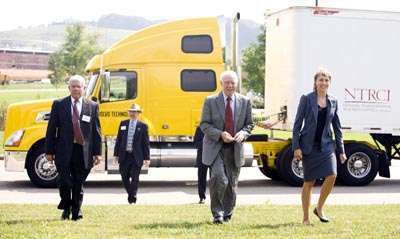
A multiyear research partnership sponsored by the National Transportation Research Center, with Volvo Trucks North America, Volvo Technology North America and the University of Tennessee as partners, reveals a model for implementing wireless roadside inspections to improve transport efficiency and increase highway safety and security.
The Trusted Truck initiative began in 2004, evaluating technology and processes to allow trucks deemed safe and “trusted” to bypass inspection stations, freeing inspectors to focus on trucks whose condition has not been validated. The study concluded with a final demonstration of Trusted Truck on Aug. 13 in Knoxville, Tenn.
U.S. Rep. James L. Oberstar of Minnesota, chairman of the Committee on Transportation and Infrastructure, joined U.S. Rep. John J. Duncan Jr., ranking member of the Highway and Transit Subcommittee, as well as government agency officials to see firsthand why Trusted Truck is a promising avenue for wireless roadside inspections.
“Trusted Truck wireless roadside inspections would provide greater efficiencies to both the public and private sector,” says Jan Hellaker, vice president of business development and government programs for Volvo Technology North America. “Carriers that have a strong commitment to maintenance and safety can expect to see immediate savings in time and fuel costs. At the same time, the highway inspection stations can have a greater impact by focusing on trucks whose condition is unknown.”
Under the latest version of the system evaluated in the effort, when a vehicle is registered as a Trusted Truck, its credentials are sent wirelessly to roadside inspectors, confirming that the driver, tractor, trailer and cargo meet all appropriate Federal Motor Carrier Safety Administration requirements for safe cargo transportation.
When monitoring systems show a healthy vehicle and up-to-date credentials, the driver is signaled to proceed past the inspection station without stopping, saving both time and fuel. The system also serves as an early-warning system, sending a message to the fleet if a part or function is degrading and could become a safety concern. On the other hand, if any problems are flagged, the truck is instructed to proceed to the upcoming inspection station and enters the inspection queue as usual.
While the benefits of wireless inspection can be significant, the Trusted Trucks research team understood that they needed to address real-world issues that could affect adoption of the system. “First, we developed the Trusted Truck technology to be used with any fleet management system,” says Tom Richter, Volvo Technology’s principal investigator for Trusted Truck. “By developing the system to work with technology that is already available and already in-use by many fleets across the U.S., we’ve largely overcome the cost and compatibility barrier.”
Volvo Link, for example, is an integrated onboard communications system that is standard equipment on all Volvo trucks sold in North America. With Volvo Link, drivers and fleet managers are able to communicate, and the operational condition of the truck can be monitored and assessed remotely. Volvo Link or other fleet management systems could tie in to the Trusted Truck system with a software addition.
Secondly, Trusted Truck uses existing wireless technology, enabling it to be put into service quickly. Just as importantly, the system can work with other intelligent transportation systems initiatives that are planned or in development.
An additional factor is the commitment to confidentiality. All vehicle data is encrypted and sent to a nongovernment third-party Trusted Truck Management Center, which gives the driver the go/no-go signal.
As this phase of the Trusted Trucks initiative ends, Volvo and its partners hope to see a public-private partnership come together for a large-scale pilot project involving one or more large fleets operating on a high-volume interstate.













